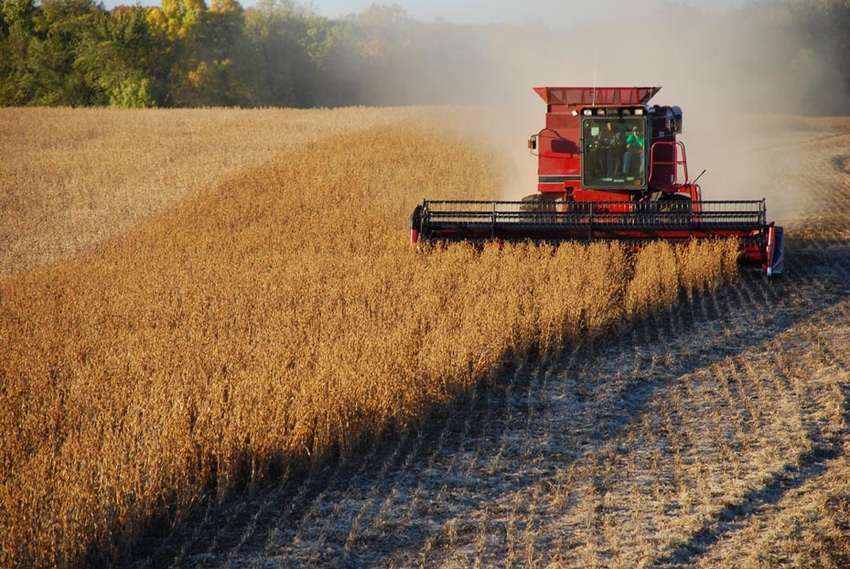
Soybean bulls avoid a bearish bullet, as the USDA offsets a higher yield estimate of 53.1 bushels per acre, with a -514,000 reduction in harvested acres. Increases for North Dakota, Nebraska, and Iowa were more than offset by reductions in many other states. Interestingly, the USDA is now showing the number of pods per acre at 1,900, a fresh new record. Beginning stocks were raised higher by +43 million bushels. Demand was left "unchanged."
Global soybean ending stocks were raised higher from 108.26 to 110.04 MMTs. Global soybean output is projected at a record 369.5 million tons, up 0.2 million with higher production for Canada partly offset by lower projections for India, Mexico and the U.S..
The on-farm season-average soybean price is left "unchanged" between $7.35 and $9.85 per bushel. As for U.S. and Chinese trade talk, there's very little fresh or new to report. There's seems to be an on-again off-again meeting between President Trump and Chinese President Xi Jinping, being scheduled somewhere around the end-of-November G20 meeting in Argentina. It's still a ways off on the horizon, but perhaps there's some hopes of a resolution between the words two largest economies?
Technically, most still see nearby support in the NOV18 contract down in the $8.40 to $8.50 range. Resistance is still thought to be in the $9.00 to $9.20 range.
As a spec, I am still unwilling to buy breakouts to the upside, preferring to make a play on the next round of bearish trade headlines involving the Chinese. I still think there will be another round of bearish headlines.
As a producer, I will be looking to reduce some additional nearby risk on a rally to upper end of the range.
Corn prices have climbed to multi-week highs on thoughts of improved trade negotiations, late U.S. harvest weather complications, and continued strong demand. Washington has inked deals with both Mexico and Canada, now there are rumors that U.S. leaders are considering a 'Trade Coalition' with Japan and the European Union to confront China.
Rains have been heavy in many parts of the U.S., with several areas still having corn in the fields. The rains will continue through mid-week adding big complications in parts of the Plains and northwestern Midwest. There's also talk of heavy snow by mid-week in parts of North Dakota. The longer-term 2-to-4 week forecast shows things turning warmer and drier, but between now and then the market could become more concerned. Bulls are hoping the weather threats, strong demand, and improved trade negotiations will help force more shorts to the sideline. Bulls are also pointing to potential tailwind coming from President Trump's visit to Council Bluffs, Iowa tomorrow.
Thoughts are we will hear some type of formal announcement directing the Environmental Protection Agency (EPA) to lift the summer ban on E15 gasoline and perhaps tightening restrictions on the trading of ethanol blending credits to keep prices down for merchant refiners struggling with the cost of complying with the U.S. Renewable Fuel Standard (RFS).
As I've mentioned in previous reports, the American Petroleum Institute (API) is strongly opposing both the E15 waiver and the proposed trade restrictions, saying the measures would hurt consumers and damage liquidity in the credit market, so the trade is wondering exactly how it will all play out. I suspect we will be a bit smarter tomorrow after listening to the Iowa press conference. Don't forget, we also have a highly anticipated USDA supply and demand report scheduled for release on Thursday. The U.S. yield and overall demand adjustments are in the spotlight. From a technical perspective, as I've mentioned the past several weeks, there are several technical hurdles that could be difficult to clear up between $3.75 and $3.90 per bushel in the DEC18 contract.
As a producer, I will be looking to reduce a bit more nearby price risk should we test the upper-end of this range. I'm also keeping a close eye on the new-crop DEC19 contract, which is now at or around $4.00 per bushel. It will be interesting to see how much U.S. corn was "harvested" this past week. Last Monday, the USDA estimated we were 26% harvested, which was well ahead of our historical 5-year average. Let's also keep in mind, many of the largest production states were still showing extremely strong crop-conditions: Illinois corn was rated 80% "Good-to-Excellent"; Nebraska 83% GD/EX; Minnesota 78% GD/EX; and Iowa rated 75% GD/EX. It will be interesting to see if they show the"weather" starting to have a little negative impact? Staying patient and hoping we can continue to grind higher...
The opinions of the author are not necessarily those of Corn+Soybean Digest or Farm Progress.
To gain more insights for your operation, click HERE for a FREE TRIAL of the Van Trump Report.
About the Author(s)
You May Also Like






